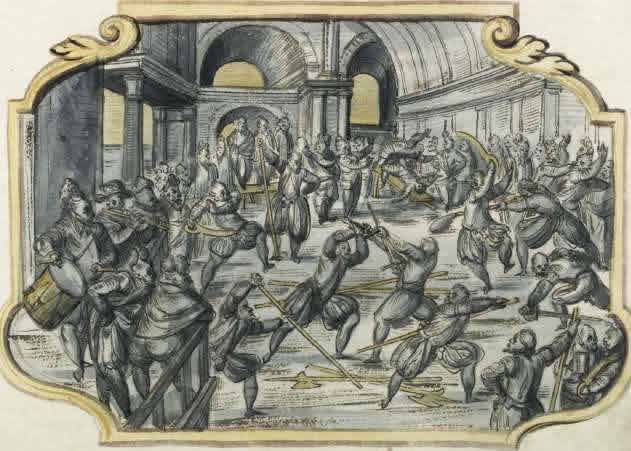
Some Very Basic Training
Tips for Students of Historical Fencing
For practicing Renaissance fighting arts and historical swordsmanship
today, the following basic advice is offered for novice students.
This
is a fighting art of self-defense. Approach it as such. It is not
about display, or contests, or costumed role-play. You have to exercise
and train in order to practice what you learn.
Never
ignore the importance of free-play/sparring. Always endeavor to engage
as many sparring partners as you can and particularly the better ones.
The better the opponent, the more you will be challenged and the more
you will learn about yourself. Training with only inferior opponents
will not bring you to your highest level and can even lead to lazy
habits. Do not neglect free-play with blunt steel blades. Do
not rely on padded weapons for your understanding.
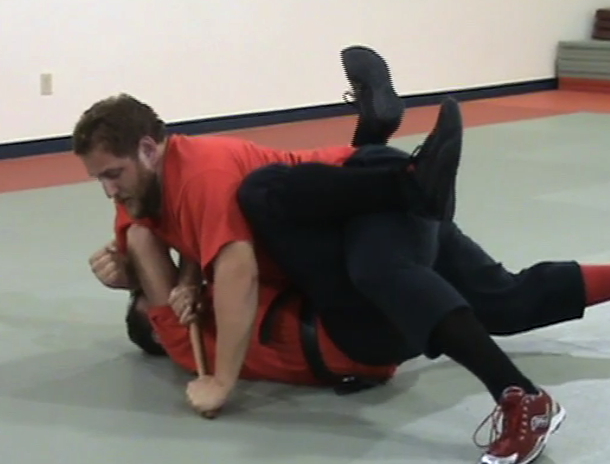 Cross train. Whatever form
of historical fencing you are pursuing, realize that training is a
continual, never-ending process. Seek out as many varieties and methods
of swordsmanship and weapon sparring as you can find. Almost any method
has some virtues to offer and practicing exclusively with only one
method is limiting. Cross train. Whatever form
of historical fencing you are pursuing, realize that training is a
continual, never-ending process. Seek out as many varieties and methods
of swordsmanship and weapon sparring as you can find. Almost any method
has some virtues to offer and practicing exclusively with only one
method is limiting.
Research.
Scholarship is an important part of this craft. Read and study
everything you can find on the subject and pay special attention to the
works of the historical masters. Don’t exclude the wealth of
information available in either sport fencing or the modern Asian
martial arts. But don’t forget that to question, doubt, and inquire is
part of our Western heritage. Nor should you assume that all ways of
moving and handling of all weapons all equal in all parts of the world
with all people and cultures throughout all ages of history. Think
about it.
Practice
hard and often. Although it’s a cliche’, the three most important
things in gaining true martial skill are: practice, practice,
practice. Don’t treat it as a short term activity. But remember, what
they teach in the modern fencing today is not the historical
reality and what is found now in many martial arts styles is useless.
Whether or not competent instruction is available to you, there are
still numerous exercises, drills and routines that should be followed
according to the counsel of the historic Masters of Defence.
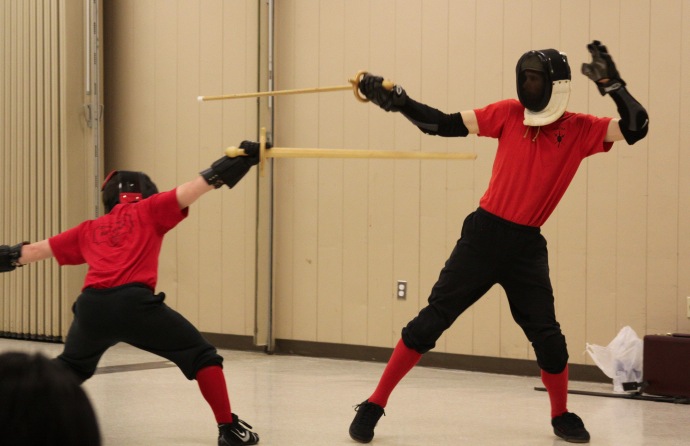 Some rudimentary suggestions for training in Renaissance fencing: Some rudimentary suggestions for training in Renaissance fencing:
- practice using both
single-hand and two-hand grips (i.e., side-sword and long-sword)
- practice single as well as double-handed swords as well as the rapier
- practice use and coordination of a shields
- practice cuts and strikes (for proper delivery, angle, flow, and
recovery)
- practice full-contact strikes at a fixed target or pell (for
power and focus)
- practice stepping and footwork on its own
- practice controlled strikes and cuts at a mobile target
- practice strike and counter-strike combinations with and without a partner
- practice use and coordination of two weapon combinations, such as sword and buckler or dagger
- conduct safe contact sparring with controlled intent (using wooden
weapons or blunt steel training blades)
- spar at full speed and full-body targets (wearing helmets)
- spar without verbal comment or instruction
- spar by alternating offense only/defense only
- practice with dissimilar weapons against one another
- practice against (and with) pole-weapons,
- conduct test-cutting with a sharp live-blade (to understand how
it’s really functions)
- include grappling/wrestling and empty-hand actions in all training
- do some aerobic exercise for stamina
- do some form of weight training for strength
Some additional suggestions specific to rapier training:
- practice thrusts
- practice footwork (for speed, agility, and mobility)
- practice lunges and recovering
- practice point-control at a fixed target
- practice attack and counter-attack combinations with and without a partner
(to gain coordination and reflexes)
- train with and without a second-hand weapon (dagger, buckler,
etc.)
- practice with the sword held in the opposite hand
- practice with single dagger against single dagger, and against
rapier & dagger
- practice routines with a historically accurate replica
- conduct constant sparring (the only way to learn timing, perception,
proper movement and feedback)
- practice with and against a side-sword/cut-and-thrust swords
 Swordsmanship,
as with most martial-arts, is a path not a destination. Keep in mind
that while there are certain universal concepts of fighting (i.e.,
perception, distance, timing, technique, attitude), every form of
weapon use or method of swordsmanship has its own historical context.
No one style or form should not be viewed as an end-all, be-all, ultimate
method. There really is no "best sword" or "best weapon".
It is as much mental (psychological) as physical. Above all should
be the realization that when this activity is treated as a historical
fighting art, it takes discipline and physical conditioning. It does
not work well with a light-hearted, romanticized, weekend past-time
approach. It is a true martial-art and really should be treated as
such. If you come to feel inadequate or lacking in skill during your
learning and training, this is a good sign for it means you are honestly
recognizing you could be better and that there is more to higher skill
than you yet know. The desire to improve is a further step down the
path. Swordsmanship,
as with most martial-arts, is a path not a destination. Keep in mind
that while there are certain universal concepts of fighting (i.e.,
perception, distance, timing, technique, attitude), every form of
weapon use or method of swordsmanship has its own historical context.
No one style or form should not be viewed as an end-all, be-all, ultimate
method. There really is no "best sword" or "best weapon".
It is as much mental (psychological) as physical. Above all should
be the realization that when this activity is treated as a historical
fighting art, it takes discipline and physical conditioning. It does
not work well with a light-hearted, romanticized, weekend past-time
approach. It is a true martial-art and really should be treated as
such. If you come to feel inadequate or lacking in skill during your
learning and training, this is a good sign for it means you are honestly
recognizing you could be better and that there is more to higher skill
than you yet know. The desire to improve is a further step down the
path.
A
good training program should include a wide variety of activities. It
is important to develop physical attributes, technical skill and
martial spirit. This page offers some ideas on how to achieve this. It
is about training methods not fighting techniques themselves.
Test Cutting
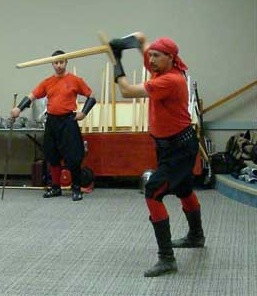 Anyone
claiming to be a serious swordsman who has never used sharp weapons at
length on realistic test-targets is bogus. It is vitally important to
training and takes considerable practice. Practice cutting must be done
on a regular basis to sharpen skills. It teaches the subtleties
involved and prevents improper techniques from developing. Many
historical fencing groups today can be seen using ridiculous cuts that
would not work with real weapons on real targets. These bad techniques
develop and become popular because poor sparring guidelines and
mediocre training encourage their use. A serious practitioner should
practice all of their cuts on a variety of test targets. Sticking to
the basic cuts at first until they are competent. Recommended targets
include: bamboo, fresh tree saplings wrapped in wet straw or wet
cardboard, thick cardboard tubes soaked in water, thick rope, thick
plant fiber, raw meat and bone, wooden 2x4 posts, and scrap armor or
helmets. When starting out, simple targets like plastic soda bottles,
water or milk jugs, foam pool noodles are useful. But realize these
things and thin plywood are all feeble targets that offer no real
lesson nor any substantial test. Above all, if you practice cuts at a
target with any kind of blade be especially careful and take things
slow. It takes practice as it can be a very hazardous activity. Anyone
claiming to be a serious swordsman who has never used sharp weapons at
length on realistic test-targets is bogus. It is vitally important to
training and takes considerable practice. Practice cutting must be done
on a regular basis to sharpen skills. It teaches the subtleties
involved and prevents improper techniques from developing. Many
historical fencing groups today can be seen using ridiculous cuts that
would not work with real weapons on real targets. These bad techniques
develop and become popular because poor sparring guidelines and
mediocre training encourage their use. A serious practitioner should
practice all of their cuts on a variety of test targets. Sticking to
the basic cuts at first until they are competent. Recommended targets
include: bamboo, fresh tree saplings wrapped in wet straw or wet
cardboard, thick cardboard tubes soaked in water, thick rope, thick
plant fiber, raw meat and bone, wooden 2x4 posts, and scrap armor or
helmets. When starting out, simple targets like plastic soda bottles,
water or milk jugs, foam pool noodles are useful. But realize these
things and thin plywood are all feeble targets that offer no real
lesson nor any substantial test. Above all, if you practice cuts at a
target with any kind of blade be especially careful and take things
slow. It takes practice as it can be a very hazardous activity.
Solo Exercise
This is obviously mandatory for
developing the most basic skills in the most basic techniques. It can
be done with real weapons or training weapons. Use care with real
weapons. It is easy to hit yourself when trying new techniques as you
first start out. If done with vigor it can be a great workout. It can
be done with or without a target to impact strikes on. Videotape your
sessions to help yourself improve.
Free-Play / Sparring
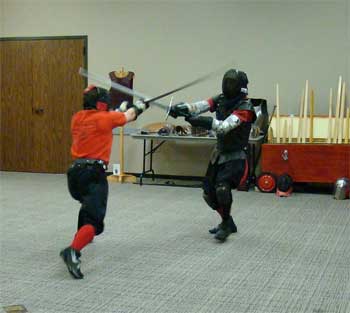 There
is nothing like the real thing. However the real thing is illegal and
something to be avoided. So the next best thing will do: fighting
against opponents with a safe sparring system. How you go about this is
very important though. Every sparring system has strengths and
weaknesses. Each system emphasizes a different aspect of combat. The
important thing to know is what those strengths and weaknesses are.
Then use a variety of systems to give yourself
balance. Ultimately,
however, adopting any curriculum for martial arts practice is not just
a matter
of your views toward training or techniques, rather, it's about having
a philosophy of learning a combative discipline. If your views
are to focus on sportified contests or sparring (even though neither is
actually a martial art) or to focus on form over function, your
practice will reflect those limitations and your learning will suffer
in the end. Sparring is a means to leanr the art not the end focus of
the art. There
is nothing like the real thing. However the real thing is illegal and
something to be avoided. So the next best thing will do: fighting
against opponents with a safe sparring system. How you go about this is
very important though. Every sparring system has strengths and
weaknesses. Each system emphasizes a different aspect of combat. The
important thing to know is what those strengths and weaknesses are.
Then use a variety of systems to give yourself
balance. Ultimately,
however, adopting any curriculum for martial arts practice is not just
a matter
of your views toward training or techniques, rather, it's about having
a philosophy of learning a combative discipline. If your views
are to focus on sportified contests or sparring (even though neither is
actually a martial art) or to focus on form over function, your
practice will reflect those limitations and your learning will suffer
in the end. Sparring is a means to leanr the art not the end focus of
the art.
Sharps - ("real
weapons")
No, you can't really spar with real and sharpened
weapons. But safe solo training with a sharp blade will
give you an appreciation for the feel and effort real weapons demand
and the damage sharp edges can suffer under improper technique.
Federschwerter / Practice-Blunts
"Featherswords" (or foyles) are unsharpened historically-accurate training swords (not stage-combat weapons, not props, and not "wall-hanger" replicas).
With such blunted practice
weapons it is possible to make controlled contact blows on
restricted target areas. These blunted tools are now available in
various models especially designed for historical fencing study. But,
avoid
most blunt reproduction weapons as these as they are typically too
thick, too heavy, improperly designed, and incorrectly balanced for
serious martial arts practice.
Wooden weapons
(wasters)
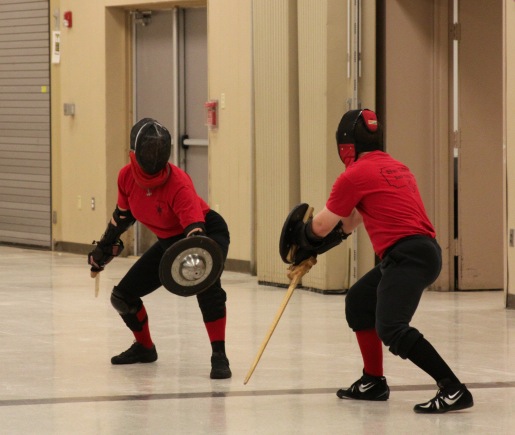 Wooden
substitutes were historically used fro almost all manner of weapons.
Good wooden swords can be used almost as fast and hard as blunted steel
blades depending on the amount of control, skill, armor, and target
areas employed. They obviously do not perform as accurately as steel
practice blades, yet have a more realistic feel than padded sparring
weapons but require more restrictions on technique. Wooden weapons
should be made with a distinctive edge (i.e., flattened instead of
round) and have a realistic weight. The farther you get away from
historical weapons the more likely you are to learn bad habits.
Inrecent years a number of carbon-fiber or platic nylong wasters
have appeared. After having first pioneered their use, following two
years of trial we discarded them as unsuitable due to their inherent
over-flexing and unrealistic handling that distorts proper historical
technique. Wooden
substitutes were historically used fro almost all manner of weapons.
Good wooden swords can be used almost as fast and hard as blunted steel
blades depending on the amount of control, skill, armor, and target
areas employed. They obviously do not perform as accurately as steel
practice blades, yet have a more realistic feel than padded sparring
weapons but require more restrictions on technique. Wooden weapons
should be made with a distinctive edge (i.e., flattened instead of
round) and have a realistic weight. The farther you get away from
historical weapons the more likely you are to learn bad habits.
Inrecent years a number of carbon-fiber or platic nylong wasters
have appeared. After having first pioneered their use, following two
years of trial we discarded them as unsuitable due to their inherent
over-flexing and unrealistic handling that distorts proper historical
technique.
Padded contact-weapons
Since 2008 the ARMA no longer
advocates the use of any padded weapons in its curricula for historical
fencing. After more than two decades experience with various designs
and models we have ceased advocating their use for serious study.
Side-Swords and Replica
Rapiers
Various
flexible rapier simulators are available that offer long tapering
blades of diamond, lozenge, or hexagonal cross-section. They are
very often still far too "whippy" to make them ideal for historically
accurate fencing. Most are little more than "steel noodles" intended
for
concocted martial sports and do not permit true
techniques (especially the thrusting of the slender rapier). Even some
brands of longsword practice-blades suffer this defect now. While
too flexible most of the time they are often
far better than modern fencing foils or epees, which are unrealistic
for simulating the longer, heavier, and wider rapier.
A historically accurate replica rapier blade, vital for general
practice, is best for training as well as free-play, provided the
point is both completely blunted and padded. Unfortunately, few blades
of this kind are available at present. As a historically accurate
alternative, a simple wooden foyle -- made from a tapered hard wooden
rod, can serve for training as well as contact bouting. Curiously,
there is currently no historical evidence that flexible practice
rapier blades were actually used for the study of the rapier, as there
would later be for the far lighter and shorter 18th century smallsword.
Instruction and Training
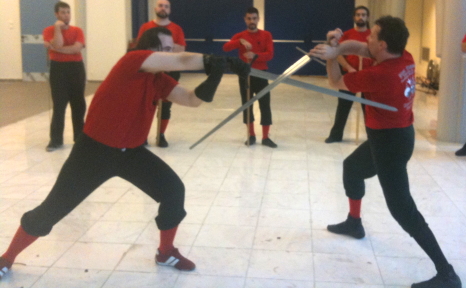 If
you seek out instruction in Medieval and Renaissance fighting arts
there are several considerations to appraise before committing to
studying with them: Do they have a clear study approach and
identifiable methodology? Does their understanding come from years of
private effort, or the recent collections of other novices? Do
they have an actual program of drills and exercises with proven
results? Have they any actual accomplishments or achievements in this
craft? Does physical conditioning and martial intent come across in
their displays? Do they convey maturity and sincerity in their efforts?
Do they exhibit concern with high standards, or more with artificial
competitions and living-history escapism? Do their activities seem
focused more on a historical combat discipline or a modern combat
sport? Do they have demonstrable skill and experience in self-defense
teachings? Is their background in the authentic revival of this
material, or is it derived from Asian styles, sport fencing
credentials, and stage-combat theory? Do they promote a sense of
camaraderie, ethical conduct, and scholarship, or do they seem
commercial, theatrical, sportified, or amateurish? Is their curriculum
run by committee or is someone competent in authority? And lastly, do
they seem to need you more than you need them? These are
important matters that at their heart are issues of character and
motive as much as method and goal. Throughout history experienced
martial artists of all styles discovered that, in the long run such
factors, which might seem to have nothing to do with learning to fight,
in fact, have everything to do with the kind of fighter you become. Every
student of the martial arts must live with the real consequences of how
they train, and with whom they train, not the good intentions of either. If
you seek out instruction in Medieval and Renaissance fighting arts
there are several considerations to appraise before committing to
studying with them: Do they have a clear study approach and
identifiable methodology? Does their understanding come from years of
private effort, or the recent collections of other novices? Do
they have an actual program of drills and exercises with proven
results? Have they any actual accomplishments or achievements in this
craft? Does physical conditioning and martial intent come across in
their displays? Do they convey maturity and sincerity in their efforts?
Do they exhibit concern with high standards, or more with artificial
competitions and living-history escapism? Do their activities seem
focused more on a historical combat discipline or a modern combat
sport? Do they have demonstrable skill and experience in self-defense
teachings? Is their background in the authentic revival of this
material, or is it derived from Asian styles, sport fencing
credentials, and stage-combat theory? Do they promote a sense of
camaraderie, ethical conduct, and scholarship, or do they seem
commercial, theatrical, sportified, or amateurish? Is their curriculum
run by committee or is someone competent in authority? And lastly, do
they seem to need you more than you need them? These are
important matters that at their heart are issues of character and
motive as much as method and goal. Throughout history experienced
martial artists of all styles discovered that, in the long run such
factors, which might seem to have nothing to do with learning to fight,
in fact, have everything to do with the kind of fighter you become. Every
student of the martial arts must live with the real consequences of how
they train, and with whom they train, not the good intentions of either.
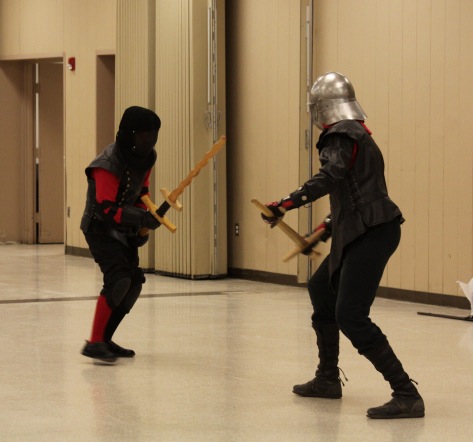 Lastly, there
is something else to consider when acquiring practice partners. Finding
opponents who equally match one’s particular level of ability can be
difficult. Quite often they are either noticeably superior or inferior.
Though one may practice with individuals with whom you are better than
and can readily outperform, it is important not to allow yourself to
become lax. Resist the feeling to fight softer or to quit trying in an
effort to somehow make things "more interesting and challenging." This
attitude not only does a disservice to your true skills, but also to
your sparring partner by not offering them an honest test. Practice
like this surely leads to bad habits and weakens one’s edge. This is
not to say that when facing those you are truly superior to that one
should always crush and overwhelm them. Not at all. For in those cases
you obviously need to teach and instruct without diminishing an
individual or breaking their spirit. On the other hand, if one faces
partners against whom you are soundly beaten, one must avoid the urge
to view it entirely in terms of simply something we failed to do or
entirely in terms of something the opponent did. This is not useful for growth as a student of the art.
Victory or defeat is always a matter of that which we do or fail to do,
in combination with that which an adversary did or failed to do.
Sometimes the two are indistinguishable. Seek partners who
share the same motivations, objectives, and values in the craft.
If you share the same values and objectives, then you will find a
matching approach and method. It will then be all the easier to learn
together. Lastly, there
is something else to consider when acquiring practice partners. Finding
opponents who equally match one’s particular level of ability can be
difficult. Quite often they are either noticeably superior or inferior.
Though one may practice with individuals with whom you are better than
and can readily outperform, it is important not to allow yourself to
become lax. Resist the feeling to fight softer or to quit trying in an
effort to somehow make things "more interesting and challenging." This
attitude not only does a disservice to your true skills, but also to
your sparring partner by not offering them an honest test. Practice
like this surely leads to bad habits and weakens one’s edge. This is
not to say that when facing those you are truly superior to that one
should always crush and overwhelm them. Not at all. For in those cases
you obviously need to teach and instruct without diminishing an
individual or breaking their spirit. On the other hand, if one faces
partners against whom you are soundly beaten, one must avoid the urge
to view it entirely in terms of simply something we failed to do or
entirely in terms of something the opponent did. This is not useful for growth as a student of the art.
Victory or defeat is always a matter of that which we do or fail to do,
in combination with that which an adversary did or failed to do.
Sometimes the two are indistinguishable. Seek partners who
share the same motivations, objectives, and values in the craft.
If you share the same values and objectives, then you will find a
matching approach and method. It will then be all the easier to learn
together.
Now get off your chair and go fight!
More
detailed information and guidance is available in the Member's
section on Training featuring material on content, structure,
equipment, and organization, as well as on conducting practices and
classes.
|

